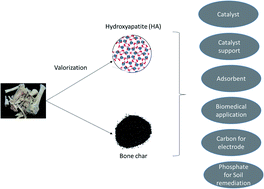Value-added materials recovered from waste bone biomass: technologies and applications
Abstract
As the world population increases, the generation of waste bones will multiply exponentially, increasing landfill usage and posing health risks. This review aims to shed light on technologies for recovering valuable materials (e.g., alkaline earth material oxide such as CaO, hydroxyapatite, beta tri-calcium phosphate, phosphate and bone char) from waste bones, and discuss their potential applications as an adsorbent, catalyst and catalyst support, hydroxyapatite for tissue engineering, electrodes for energy storage, and phosphate source for soil remediation. Waste bone derived hydroxyapatite and bone char have found applications as a catalyst or catalyst support in organic synthesis, selective oxidation, biodiesel production, hydrocracking of heavy oil, selective hydrogenation and synthesis of bioactive compounds. With the help of this study, researchers can gather comprehensive data on studies regarding the recycling of waste bones, which will help them identify material recovery technologies and their applications in a single document. Furthermore, this work identifies areas for further research and development as well as areas for scaling-up, which will lead to reduced manufacturing costs and environmental impact. The idea behind this is to promote a sustainable environment and a circular economy concept in which waste bones are used as raw materials to produce new materials or for energy recovery.



 Please wait while we load your content...
Please wait while we load your content...